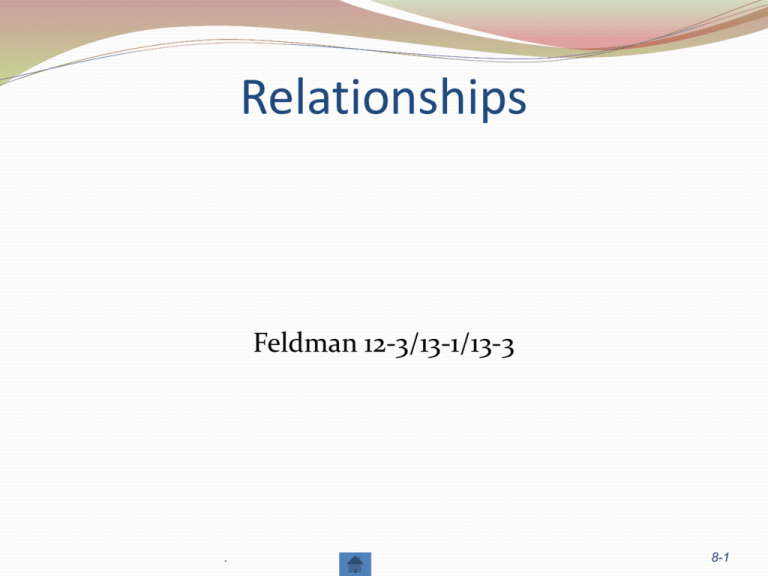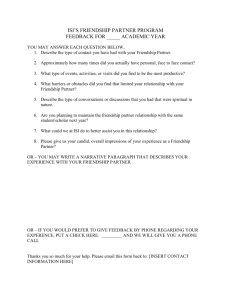
Relationships
Feldman 12-3/13-1/13-3
.
8-1
FORMING RELATIONSHIPS:
Factors in Attraction
Similarity
Proximity & Familiarity
Physical Attractiveness
(Personality Traits)
8-2
Similarity
Similarity is when someone else’s attitudes and
behavior are similar to ours.
It provides:
Consensual validation – support for our own attitudes
and behavior
Comfort – lack of conflict and a feeling of shared
understanding between the individuals
. . . the people we like most are usually similar to us.
8-3
Familiarity and Similarity
Familiarity is necessary for a close relationship to develop
Moreland and Beach (1992) found students said they liked women who
attended class more often, even though the targets didn’t interact with
anyone
Familiarity happens with repeated exposure. The “mere
exposure effect” says that the more we are exposed to a
person or object, the more positive our feelings about it
become.
Proximity or geographical nearness leads to repeated
opportunities for exposure and allows familiarity to
develop.
8-4
Physical Attractiveness
In the process of selecting new people to get to know,
we tend to judge them to some extent by their physical
attractiveness.
Some qualities, such as good grooming, may indicate
desirable personality traits.
8-5
Physical Attractiveness
Men may be more affected by physical attractiveness
than are women.
Heterosexual men rate as important in women:
good looks
cooking skills
frugality
And women know and respond to this:
Buss (1988) found that women use tactics that alter their
appearance (wear make-up, keep well-groomed, wear
stylish clothes, wear jewelry).
8-6
Physical Attractiveness
And women have different criteria.
When seeking an intimate partner, heterosexual women
rate as important in men:
Considerateness
Honesty
Dependability
Kindness
Understanding
Buss (1988) found that men use tactics that involve
resource possession and display (brag about cars and
money, display strength) to impress women.
©
8-7
Physical Attractiveness
The Matching Hypotheses says that although most
people would like to go out with 10’s, when it comes
down to it, most of us select people whom we believe
match our own level of attractiveness.
8-8
Personality Traits
Anderson (1968) found we are attracted to people with
personality traits such as being:
sincere
honest
understanding
loyal
truthful
trustworthy
intelligent
dependable
©
8-9
Aging and the Social World
Social Network – Social Support
Social Convoy model of social relations — go through
life embedded in personal network of individuals that
give social support
Helps those of all ages cope
Improves mental and physical health
Linked to reduced symptoms of disease
Linked to longevity
Emotionally positive contact lowers depression
The composition (people) of the convoy changes, but
it does not go away.
Peer Relations in Childhood and Adolescence
Peer Group Functions
Peers — individuals about the same age or maturity
level
Peer groups provide source of information and
comparison about world outside the family
Peer influences and evaluations can be negative or
positive and can influence our self-concept, selfesteem, and/or behavior.
Friendship
Six Functions of Friendship
Companionship
Stimulation
Physical support
Ego support
Social comparison
Intimacy/affection
intimacy in friendship — self-disclosure
and sharing of private thoughts
Friendship
Strategies for Making Friends
Appropriate
• Initiate interaction
• Be nice
• Behave prosocially
• Show respect
• Give social support
Inappropriate
Be psychologically
aggressive
Present oneself
negatively
Behave antisocially
Social or Relationship Skills
Probably start in the home, perhaps as early as infancy.
Develop as a person grows.
In pre-school years are developed through play.
©
8-14
Play and Leisure
Childhood
Functions of play
Health
Affiliation with peers
Cognitive development
Exploration
Tension release, master anxiety and conflicts
Play therapy
Play and Leisure
Parten’s Classic Study of Play
Unoccupied
Solitary
Onlooker
Parallel
Child not engaging in play as commonly
understood; might stand in one spot
Child plays alone, independently of others
Child watches other children play
Child plays separately from others, but in
manner that mimics their play
Play that involves social interaction with
Associative
little or no organization
Play that involves social interaction in
Cooperative
group with sense of organized activity
Play and Leisure
Types of Play
Infants derive pleasure from exercising
Sensorimotor
their sensorimotor schemes
Practice
Repetition of behavior when new skills
are being learned
Pretense/
Symbolic
Occurs when child transforms physical
environment into symbol
Social
Involves social interactions with peers
Games
Activities engaged in for pleasure;
include rules
Peer Relations in Childhood and Adolescence
Developmental Changes
Early Childhood
Frequency of peer interaction increases
Middle/Late Childhood
Children spend increasing time in peer interaction
Average time spent
10% of time spent with peers at age 2
20% of time spent with peers at age 4
40% of time spent with peers during ages 7-11
Peer Relations in Childhood and Adolescence
Peer Statuses
Popular
Average
Frequently nominated as a best
friend; rarely disliked by peers
Receive average number of positive
and negative nominations from
peers
Neglected
Infrequently nominated as a best
friend but not disliked by peers
Rejected
Infrequently nominated as a best
friend; actively disliked by peers
Controversial
Frequently nominated as someone's
best friend and as being disliked
Friendship
Friendship during Childhood
Children use friends as cognitive and social
resources
Not all friends and friendships are equal
Supportive friendships advantageous
Coercive, conflict-ridden friendships not
Friends generally similar — age, sex, ethnicity,
and many other factors
The Nature of Friendship Changes During Childhood
Damon & Hart (1988) found that friendships are for:
4-7 year olds – opportunities for interaction, liking
and sharing
8-10 year olds – appreciation of personal qualities and
mutual trust
11-15 year olds – psychological closeness, intimacy and
loyalty
8-21
Friendship
Friendship during Adolescence
Need for intimacy intensifies
Quality of friendship more strongly linked to
feelings of well-being
Important sources of support
Friends are active partners in building a sense of
identity
Friendship
Friendship during Adolescence
Friendships in adolescence and adulthood tend to be
intimate relationships involving trust, acceptance,
liking and mutual understanding.
The benefits include:
reducing loneliness
being a source of self-esteem
providing emotional support
providing information and social comparison
fulfilling the need to be accepted or to belong
The Strategies for Keeping Friends . .
Are much the same as those for getting them initially. . . .
1. Be nice, kind, and considerate
2. Be honest and trustworthy
3. Respect others
4. Provide emotional support
©
8-24
Gender and Friendship
In childhood, boys and girls remain voluntarily gender
segregated. Boys play with boys and girls with girls.
Boys’ play tends to involve rough-and-tumble activity,
larger play groups, and the tendency to establish a
hierarchy of who has the most status.
Girls play involves smaller groups, equal status, and
social scenarios involving negotiation and compromise
(and often some drama).
8-25
Gender and Friendship
In friendships between women, women
have close friends
are likely to listen and be sympathetic
share their thoughts and feelings
use rapport talk
In friendships between men, men are more likely to
engage in activities, show competition and use report
talk.
In friendships between women and men, problems can
arise because of different expectations of romantic
involvement.
8-26
And sometimes we are temporarily without friends.
Loneliness can occur with life transitions, such as:
moving
divorce
death of friend or family member
first year of college
At the beginning of college life, 75%
said they felt lonely at least part
of the time
©
8-27
Relationships at Midlife
Sometimes family obligations can diminish
opportunities for interactions with friends.
At midlife, many people find themselves in the
“sandwich” generation, providing support to aging
parents and adult children.
Part of this may be due to the “boomerang generation”
of adult children who are returning home for such
reasons as divorce, financial problems, difficulty
finding jobs or need for more education.
8-28
Friendship
Friendship in Late Adulthood
Important role; tend to narrow social network
Choose close friends over new friends
Friends replace distant family
Gender differences
Women: more depressed without a best friend; no
change in desire for friends
Men: decreased desire for new and close friends in
older adulthood
Sexuality
What is sexuality?
Sexuality is not a personality characteristic.
Sexuality is not a level of biological drive.
Sexuality is a choice of behaviors.
Heterosexual Choices
90% of people have had sexual intercourse
by age 22
National Health & Social Life Survey (1994)
3400 18 to 59 year olds
Partners are alike in age, ethnicity, education &
religion
71% have only one sex partner per year
1/3 have sex up to twice a week; 1/3 a few times a
month; 1/3 a few times a year
Heterosexual Behavior
Married people have the most frequent sex &
most satisfying sex lives
Most popular activities intercourse, watching
partner undress
75% men, 85% women not unfaithful
Men think about sex more
Michael & others, 1994
Sexuality - Adulthood
Sexual activity increases through the 20s and
declines in the 30s.
80% of adults in committed relationships , and
88% in marriages report begin “extremely
physically and emotionally satisfied.”
Only a few report persistent sexual problems
Sex and Relationships
“Sex is a socially significant act.”
Self-concept
Future partners
Parents
Possible children
The need to belong
Best in truly intimate relationships
Why is sex best in an intimate relationship?
Physical and psychological intimacy influence each
other.
Commitment is a safeguard.
A caring rather than a using partner.
Identity/relationship issues are important.
Unregulated Sexual Behavior
Unregulated sexual behavior is a problem for any
society.
The problem is age/stage-related, in adolescence &
young adulthood
Adolescents have the highest rates of STD’s all age
groups, 1 in 6 per year
STD’s (The Short List)
National Center for Health Statistics, 2004
1 of 6 Americans has one.
Bacterial
Syphilis
Gonorrhea
Chlamydia
Viral
Genital herpes
HPV
AIDS
Cochran & Mays (1990)
20 % of men
4% of women
Indicated that they would lie to a potential sex partner
about the results of a positive HIV test.
Adolescent Pregnancy
U.S. adolescent pregnancy rate is higher than
that of most industrialized countries
40-45% of these end in abortion
75% to unmarried females
Increased social acceptance
Belief that a baby will fill a void in life
Teenage Mothers
Likely to be poor
High percentage are low-income, minorities
Tend to have limited education, poor school
performance, etc.
Effects of the Child on Circumstances
Reduces likelihood of educational attainment
Reduces the chance of marriage
Increases the chances of economic disadvantage and
welfare
Why so much irresponsible sex?
Irresponsible Mindset
Lack of clear cultural standards
religion, morality, social acceptability no longer
reasons to say no
Social acceptability: Substantial numbers of
people believe it is OK
Most high school seniors are no longer
virgins
Internal conflict – ambivalent feelings; guilt
20% use no contraception
Irresponsible Mindset
Lack of communication about birth control/sex
Alcohol & other drugs
“Romantic fog”
Why so much irresponsible sex?
Pressure
Media/TV – spontaneous passion should be
acted upon; the 40-year-old Virgin
Subculture factors – to be “normal”
Peer pressure – to be acceptable
Date pressure – to be loved
We live in a sexually coercive society.
12% of American girls and 5% of boys say they were
forced to have intercourse
Among those who had sex voluntarily, 25% said
they really did not want to do so
Sexual Coercion
Estimated 13% of women have endured rape,
legally defined as intercourse by force, by threat of
harm, or when the victim is incapable of consent
by reason of mental retardation, mental illness, or
intoxication.
1998 college survey, 44% of women had
experienced sexual coercion; 19% of men had
obtained sex through force
Why is date rape a problem?
Because too many people think it isn’t.
Taking sex too lightly – no big deal
Pornography/Myths about women
Beliefs that women enjoy rape
Misreading friendliness
Assuming that refusal is part of the game
Sexual Coercion: The Cost
Psychological reactions to rape resemble those of
trauma survivors
Shock
Confusion
Withdrawal
Chronic fatigue
Tension
Disturbed sleep
Depression/Suicidal thoughts
Homosexuals
2.7% men, 1.3% women
No real evidence of biological basis
No clear indications of social, environmental
correlates
May be an interaction of the two (nature-nurture
question)
Factors in explanation
Biological plasticity
Social tolerance
Sexual Orientation: Not Genetically Determined
Identical twin concordance rate is about 50%
Inconsistency of preference
18% heterosexual boys, 6% girls report
engaging in at least one homosexual act
Prisoners
Bisexuality
Other conditions of changing lifestyles
New Statement from APA
“There is no consensus among scientists about the exact
reasons that an individual develops a heterosexual, bisexual,
gay or lesbian orientation. Although much research has
examined the possible genetic, hormonal, developmental,
social and cultural influences on sexual orientation, no
findings have emerged that permit scientists to conclude that
sexual orientation is determined by any particular factor or
factors. Many think that nature and nurture both play
complex roles. . . “
American Psychological Association







